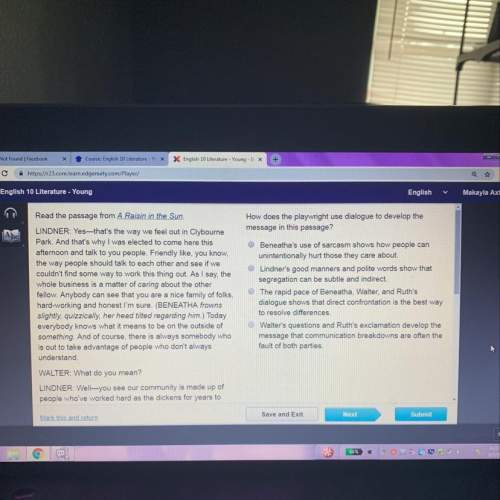"...packet of energy-rich starch..." (paragraph 4)
20.
What is the effect of the figurative...

English, 09.05.2021 04:40 georgeonnatreev3400
"...packet of energy-rich starch..." (paragraph 4)
20.
What is the effect of the figurative language "tasty prize” in paragraph 4?
A.
to explain which animals consume seeds
B.
to illustrate the food chain's competition
C.
to emphasize the seed's nutritional value
D.
to contrast the inedible parts of the tree
4

Answers: 3


Other questions on the subject: English

English, 21.06.2019 21:00, sayedabdullah
Now long and short works of fiction have different characteristics beyond simply the length of the work. think of a short story that you like and a longer work (novel or novella) that you like. you can use the story and novella from this unit if no other works come to mind quickly. discuss the elements of each work that made it enjoyable to read. what relationship did the form of the work (short story, novella, or novel) have in making it an enjoyable read? what elements of fiction were strongest in the work, and how did they impact your enjoyment of the story? compare the two works you chose. how are they representative of short fiction versus longer forms of fiction?
Answers: 1


English, 22.06.2019 02:20, issagirl05
The greatest gift the sumerians gave the world was the invention of writing. the sumerians were wealthy people. they needed some way to keep track of what they owned. they began drawing pictures. they used a reed as a pen. they drew on soft pieces of clay. the soft clay was then dried in the sun. the tablet became a permanent record. later, the sumerian drawings changed into wedge-shaped symbols. this kind of writing is called cuneiform. by putting symbols together, the sumerians could write entire sentences.
Answers: 3

English, 22.06.2019 04:50, ilawil6545
Read the passage, then answer the question that follows. no one could have seen it at the time, but the invention of beet sugar was not just a challenge to cane. it was a hint—just a glimpse, like a twist that comes about two thirds of the way through a movie—that the end of the age of sugar was in sight. for beet sugar showed that in order to create that perfect sweetness you did not need slaves, you did not need plantations, in fact you did not even need cane. beet sugar was a foreshadowing of what we have today: the age of science, in which sweetness is a product of chemistry, not whips. in 1854 only 11 percent of world sugar production came from beets. by 1899 the percentage had risen to about 65 percent. and beet sugar was just the first challenge to cane. by 1879 chemists discovered saccharine—a laboratory-created substance that is several hundred times sweeter than natural sugar. today the sweeteners used in the foods you eat may come from corn (high-fructose corn syrup), from fruit (fructose), or directly from the lab (for example, aspartame, invented in 1965, or sucralose—splenda—created in 1976). brazil is the land that imported more africans than any other to work on sugar plantations, and in brazil the soil is still perfect for sugar. cane grows in brazil today, but not always for sugar. instead, cane is often used to create ethanol, much as corn farmers in america now convert their harvest into fuel. –sugar changed the world, marc aronson and marina budhos how does this passage support the claim that sugar was tied to the struggle for freedom? it shows that the invention of beet sugar created competition for cane sugar. it shows that technology had a role in changing how we sweeten our foods. it shows that the beet sugar trade provided jobs for formerly enslaved workers. it shows that sweeteners did not need to be the product of sugar plantations and slavery.
Answers: 1
You know the right answer?
Questions in other subjects:


Mathematics, 06.11.2019 00:31




Mathematics, 06.11.2019 00:31

Biology, 06.11.2019 00:31

Mathematics, 06.11.2019 00:31





